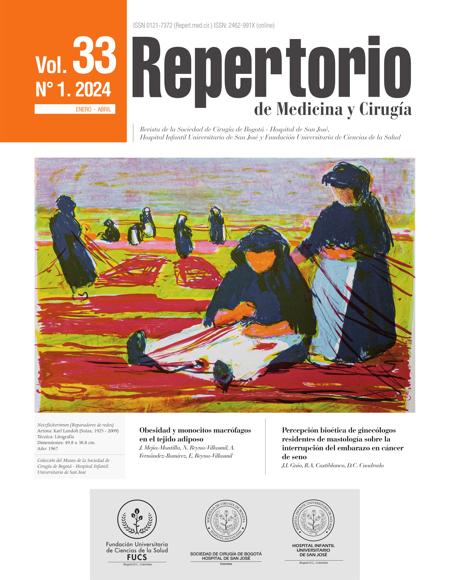Overexpression of factor VIII: risk for thrombosis and treatment
Sobreexpresión del factor VIII, riesgo de trombosis y tratamiento
![]()
![]()

Show authors biography
Introduction: Deep vein thrombosis (DVT) is a multifactorial medical condition that has been related to hypercoagulable states, alterations in blood flow and lesions in vessel endothelium. The incidence of DVT ranges between 1 and 2 cases per 1000 people and almost two million new cases per year in the United States. Some risk factors have been identified. Thrombophilias seem to play an important role in DVT etiology. Hypercoagulability states secondary to high blood coagulation factor VIII levels associated with endothelial dysfunction and increased platelet adhesion, pose a higher predisposition for thrombosis. Case report: we present the case of a 24-year-old male patient, with no relevant past history, who presented with an indurated mass in the right axillary region, which turned out to be a DVT of the external jugular vein, jugulo-subclavian confluence, supraclavicular, axillary and humeral veins with high risk of embolism. Pulmonary thromboembolism was documented and cerebral venous thrombosis was suspected. The search for procoagulant states yielded no results. Factor VIII levels were measured revealing an overexpression of factor VIII at 223% [normal range 50 – 200%]. A literature review determined warfarin to be the proper treatment.
Article visits 633 | PDF visits 360
Downloads
- Spychalska-Zwolińska M, Zwoliński T, Mieczkowski A, Budzyński J. Thrombophilia diagnosis: a retrospective analysis of a single-center experience. Blood Coagul Fibrinolysis [Internet] 2015;26(6):649-654. doi:10.1097/MBC.0000000000000332 DOI: https://doi.org/10.1097/MBC.0000000000000332
- Nishimura E, Misawa T, Kitamura H, Fujioka S, Akiba T, Yanaga, K. A case of portal vein thrombosis caused by blunt abdominal trauma in a patient with low protein C activity. Clin. J. Gastroenterol. 2018;11(6):507-513. doi: 10.1007/s12328-018-0879-8 DOI: https://doi.org/10.1007/s12328-018-0879-8
- Zamora-González Y, Agramonte-Llanes OM, Rodríguez-Pérez L. Deficiencia de proteínas C y S: marcadores de riesgo trombótico. Rev Cubana Hematol Inmunol Hemoter. 2013;29(1):40-47.
- Kaufman RJ, Pipe SW, Tagliavacca L, Swaroop M, Moussalli M. Biosynthesis, assembly and secretion of coagulation factor VIII. Blood Coagul Fibrinolysis. 1997;8 Suppl 2:S3-14.
- Hernández-Jerónimo J, Pérez-Campos E, Matadamas C, MajlufCruz A. Un nuevo factor de riesgo trombofílico: el aumento del factor VIII plasmático. Investig. Clín. 2003;55(4):448-457.
- Stevens SM, Woller SC, Bauer KA, Kasthuri R, Cushman M, Streiff M, Douketis JD. Guidance for the evaluation and treatment of hereditary and acquired thrombophilia. J Thromb Thrombolysis. 2016;41(1):154-164. doi: 10.1007/s11239-015-1316-1 DOI: https://doi.org/10.1007/s11239-015-1316-1
- Hernández V, Muñoz N, Montero MA, Camacho A, Lozano F, Fernández V. Infarto agudo de miocardio por oclusión trombótica en paciente con elevación del factor VIII de la coagulación. Rev Esp Cardiol. 2012;65(7):673-674. doi: 10.1016/j.recesp.2011.10.011 DOI: https://doi.org/10.1016/j.recesp.2011.10.011
- Gavva C, Johnson M, De Simone N, Sarode R. An Audit of Thrombophilia Testing in Patients with Ischemic Stroke or Transient Ischemic Attack: The Futility of Testing. J Stroke Cerebrovasc Dis. 2018;27(11):3301-3305. doi: 10.1016/j.jstrokecerebrovasdis.2018.07.032 DOI: https://doi.org/10.1016/j.jstrokecerebrovasdis.2018.07.032
- Brandt JT. Measurement of factor VIII. A potential risk factor for vascular disease. Arch Pathol Lab Med. 1993;117(1):48-51.
- Laffan MA, Manning R. The influence of factor VIII on measurement of activated protein C resistance. Blood Coagul Fibrinolysis. 1996;7(8):761-765. doi: 10.1097/00001721-199611000-00003 DOI: https://doi.org/10.1097/00001721-199611000-00003
- Henkens CM, Bom VJ, & Van der Meer J. Lowered APC-sensitivity ratio related to increased factor VIII-clotting activity. Thromb Haemost. 1995;74(04):198-1199. DOI: https://doi.org/10.1055/s-0038-1649904
- Carroll BJ, Piazza G. Hypercoagulable states in arterial and venous thrombosis: When, how, and who to test?. Vascular Medicine. 2018;23(4):388-399. doi: 10.1177/1358863X18755927 DOI: https://doi.org/10.1177/1358863X18755927
- Lim MY, Moll S. Thrombophilia. Vascular Medicine. 2015;20(2):193-196. https://doi.org/10.1177/1358863X15575769 DOI: https://doi.org/10.1177/1358863X15575769
- Connors JM. Thrombophilia testing and venous thrombosis. N Engl J Med. 2017;377(12):1177-1187. doi: 10.1056/NEJMra1700365 DOI: https://doi.org/10.1056/NEJMra1700365
- Bittar LF, de Moraes Mazetto B, Andrade Orsi FL, Collela MP,De Paula EV, Annichino-Bizzacchi JM. Long-term increased factor VIII levels are associated to interleukin-6 levels but not to post-thrombotic syndrome in patients with deep venous thrombosis. Thromb Res. 2015;135(3):497-501. doi: 10.1016/j.thromres.2014.12.024 DOI: https://doi.org/10.1016/j.thromres.2014.12.024
- Algahtani FH, Stuckey R. High factor VIII levels and arterial thrombosis: illustrative case and literature review. Ther Adv Hematol. 2019;10: 2040620719886685. doi:10.1177/2040620719886685 DOI: https://doi.org/10.1177/2040620719886685
- McBride A, Diri R, Krishnadasan R, Chalasani P, Abraham I, Campen C. Evaluation of direct oral anticoagulants in the treatment of venous thromboembolism for inherited thrombophilia disorders. Blood. 2016;128(22):50007. https://doi.org/10.1182/blood.V128.22.5007.5007 DOI: https://doi.org/10.1182/blood.V128.22.5007.5007
- Julapalli VR, Bray PF, Duchini A. Elevated Factor VIII and Portal Vein Thrombosis. Dig Dis Sci. 2003;48(12):2369-71. doi:10.1023/b:ddas.0000007877.17861.0a DOI: https://doi.org/10.1023/B:DDAS.0000007877.17861.0a
- Bermúdes JM, Vivas JJ, Jaramillo G, Vernal W. Trombosis venosa profunda en un paciente con hipertiroidismo de novo.Presentación de caso. Repert. Med. Cir. 2017;26(1):44-49. http://dx.doi.org/10.1016/j.reper.2017.03.004 DOI: https://doi.org/10.1016/j.reper.2017.03.004












